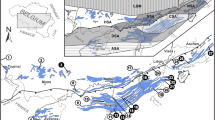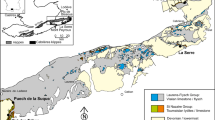Summary
East of Seefeld/Tyrol the Hauptdolomit facies (Triassic, Norian) is accompanied by an organic-rich intercalation, the Seefeld facies. Three facies were distinguished, which developed within a separate basin within the Hauptdolomit carbonate platform. These facies have been investigated in an environmental and palaeoecological context applying microfacies analysis, palynology, organic petrology, organic geochemistry and stable isotope geochemistry. As the controlling factors of sedimentation, sea level changes are suggested for large scale fluctuations, and climatic changes for variations on a smaller scale. Within the basin facies a μm-scaled rhythm can be observed, which was obviously seasonally controlled. Amajor amount of organic material of the deposit has been produced by microbial activity under anoxic conditions. Causes for the absence of pollen and spores in many black shale deposits are discussed.
Similar content being viewed by others
References
Bitterli, P. (1962): Studien an bituminösen Gesteinen aus Österreich und benachbarten Gebieten.—Erdöl-Z.78/7, 405–416, Wien
Bowen, R. (1988): Isotopes in Earth Sciences.—Elsevier Applied Science, 647 p., London (Elsevier)
Brandner, R. and Poleschinski, W. (1986): Stratigraphie und Tektonik am Kalpalpensüdrand zwischen Zirl und Seefeld in Tirol (Exkursion D am 3. April 1986).—Jber. Mitt. Oberrhein. geol. Ver., N. F.68, 67–92, Stuttgart
Bürgin, T., Eichenberger, U., Furrer, H. and Tschanz, K. (1991): Die Prosanto-Formation—eine fischreiche Fossil-Lagerstätte in der Mitteltrias der Silvretta-Decke.—Eclog. geol. Helv.84/3, 921–990, Basel
Czurda, K. (1973): Parameter und Prozesse der Bildung bituminöser Karbonate (Bituminöser Hauptdolomit).—Mitt. Ges. Geol. Bergbaust. Österr.21, 235–250, Wien.
Deeke, W. (1898): Über Fische aus verschiedenen Horizonten der Trias.—Palaeontographica35, 97–138, Stuttgart
Dobruskina, I.A. (1993): First data of the Seefeld conifer flora (Upper Triassic, Tyrol, Austria).—In: Lucas, S.G. and Morales, M. (eds.): The nonmarine Triassic.—New Mexico. Mus. Nat. Hist. and Sci. Bull.3, 113–115, Albuquerque
Eisenack A. (1973): Kleinorganismen als Zerstörer säurefester organischer Substanzen und von Biophosphaten.—Paläont. Z.47/1–2, 8–16, Stuttgart
Fischer, A.G. (1964): The Lofer Cyclothems of the Alpine Triassic. —Geol. Surv. Kans. Bull.169, 107–149, Topeka
Fischer, G. (1957) Über die Bitumenmergel von Seefeld in Tirol. —Geol. Jb.74, 63–74, Hannover
Fries, W. (1988): Fazies, Diagenese, Paläogeographie und anorganische Geochemie eines potentiellen Erdölmutter-gesteins: bituminöse und kerogenreiche Einschaltungen im Hauptdolomit (Trias, Ostalpen).—Ph.D. thesis, Universität Freiburg, 175 p., Freiburg
Fritz, P. and Smith, D.G.W. (1970): The isotopic composition of secondary dolomites.—Geochim. Cosmochim. Acta34, 1161–1173, London
Fruth, I. and Scherreiks R. (1982): Hauptdolomit (Norian)-stratigraphy, paleogeography and diagenesis.—Sediment. Geol.32, 195–231, Amsterdam
—and— (1984): Hauptdolomit-Sedimentary and Paleogeographic Models (Norian, Northern Calcareous Alps).—Geol. Rundsch.73, 305–318, Berlin, Heidelberg
Irwin, H., Curtis, C. and Coleman, M. (1977): Isotopic evidence for source of diagenetic carbonates formed during burial of organic rich sediments.—Nature269, 209–213, London
Kempe, S. (1990): Alkalinity: The link between anaerobic basins and shallow water carbonates?—Naturwissenschaften77, 426–427, Berlin
Kner, R. (1866): Die fossilen Fische der Asphaltschiefer von Seefeld in Tirol.—Sitzber. Akad. Wiss. Wien, math.-nat. Kl.54, 303–334, Wien
— (1867): Die fossilen Fische der Asphaltschiefer von Tirol. Nachtrag 1 und 2.—Sitzber. Akad. Wiss. Wien, math.-nat. Kl.56, 898–913, Wien
Köster, J. (1989): Organische Geochemie und Organo-Petrologie kerogenreicher und bituminöser Einschaltungen im Hauptdolomit (Trias, Nor) der Nördlichen Kalkalpen.—Clausthaler Geowiss. Diss.36, 1–269, Clausthal-Zellerfeld
Köster, J., Fries, W., Bechstädt, T. and Kulke, H. (1989): Kerogenreiche und bituminöse Einschaltungen im Hauptdolomit (Obertrias, Ostalpen): Modell eines karbonatischen Mutter-gesteins. —Deutsche Wissenschaftliche Gesellschaft für Erdöl, Erdgas und Kohle, Bericht361, 1–305, Hamburg
Köster, J., Wehner, H. and Hufnagel, H. (1988): Organic geochemistry and organic petrology of organic rich sediments within the “Hauptdolomit” formation (Triassic, Norian) of the Northern Calcareous Alps.—Org. Geochem.13/1–3, 377–386, Paris
Köster, J., Schouten, S., dee Leeuw, J.W., Sinninghe Damsté, J.S. (1993): Palaeoenvironmental and maturity related variations in compositions of macromeolecular organic matter and distribution of sulphur and nonsulphur biomarkers in Triassic organicrich carbonate rocks.—In: Øygard, K.E. (ed.): Organic geochemistry, Poster sessions from the 16th International Meeting on Organic Geochemistry, Stavanger 402–406, Oslo (Falch Hurtigtrykk)
Lobitzer, H., Kodina A., Solti, G., Schwaighofer, B. and Surenian, R. (1988): Fazies, Geochemie und Stratigraphie ausgewählter Vorkommen österreichischer organisch-reicher Gesteine-ein Zwischenbericht.—Geol. Pal. Mitt. Univ. Innsb.15, 85–107, Innsbruck
McCrea, J.M. (1950): On the isotopic chemistry of carbonates and a palaeotemperature scale.—J. Chem. Phys.18, 849–857, College Park
Müller-Jungbluth, W.V. (1970): Sedimentologische Untersuchungen des Hauptdolomits der östlichen Lechtaler Alpen, Tirol.—In: Mostler, H. (ed.): Beiträge zur Mikrofazies und Stratigraphie von Tirol und Vorarlberg, 255–308, Innsbruck
Palmer, S. E., Khavari Khorasani, G., and Scott, R. W. (1995): Organic Geochemistry and depositional environment of Mesozoic organic-rich carbonates.—In: Grimalt, J.O., Dorronso, C. (eds.): Organic Geochemistry: Developments and applications to energy, climate, environment and human history. Selected papers from the 17th International Meeting on Organic Geochemistry (EAOG). A.I.G.O.A., 70–73, San Sebastian
Peters, K. E. and Moldowan, J. M. (1993): The Biomarker Guide-Interpreting Molecular Fossils in Petroleum and Ancient Sediments.— 363 S., Englewood Cliffs, New Jersey (Prentice Hall)
Poleschinski, W. (1989): Stratigraphie, Fazies und Sedimentologie der Seefelder Schichten im Raum Seefeld/Tirol-ein potentielles Erdölmuttergestein aus dem Ober-Nor der Westlichen Kalkalpen.—Ph.D. thesis, Universität Innsbruck, 197 p., Innsbruck
Raupach P. (1952): Die rezente Sedimentation im Schwarzen Meer, im Kaspi und im Aralsse.—Geologie1, 78–132, Berlin
Riegel, W., Loh, H., Maul, B. and Prauss, M. (1986): Effects and causes in a black shale event-the Toarcian Posidonia shale of NW Germany.—Lect. Not. Earth. Sci.8, 267–276, Heidelberg
Rosenbaum, J. and Sheppard, S. M.F. (1986): An isotopic study of siderites, dolomites and ankerites at high temperatures.— Geochim. Cosmochim. Acta.50, 1147–1150, London
Sander, B. (1921): Über bituminöse Mergel.—Jb. Geol. Staats-Anst.71/3–4, 135–148, Wien
— (1922): Über bituminöse und kohlige Gesteine.—Mitt. Geol. Ges. Wien15, 1–50, Wien
— (1936): Beiträge zur Kenntnis des Anlagerungsgefüges (Rhythmische Kalke und Dolomite aus der Trias) I und II.— Tschermaks mineral. petrograph. Mitt.48, 27–139, 141–209 Wien
Savrda, C.E. and Bottjer, D.J. (1987): The exaerobic zone, a new oxygen deficient marine biofacies.—Nature327, 54–56, London
Sinninghe Damsté, J.S., Kenig, F., Koopmans, M.P., Köster, J., Schouten, S., Hayes, J.M. and de Leeuw, J.W. (1995): Evidence for gammacerane as an indicator of water column stratification.—Geochim. Cosmochim. Acta59, 1895–1900, London
Thiel, V., Jenisch, A., Landmann, G., Reimer, A., and Michaelis, W. (1997): Unusual distributions of long-chain alkenones and tetrahymanol from the highly alkaline Lake Van (Turkey).— Geochim. Cosmochim. Acta61, 2053–2064, London
Tintori, A. and Sassi, D. (1987): Pesci volanti del genereThoracopterus nel Norico Lombardo. Nota prelimare.—Riv. Ital. Pal. Strat.93, 337–346, Milano
Vasconcelos, C. O., McKenzie, J. A., Bernasconi S., Grujic, D., Tien, A. J. (1995): Microbial mediation as a possible mechanism for natural dolomite formation at low temperature.— Nature377, 220–222, London
Venkatesan, M.I. (1989): Tetrahymanol: its widespread occurrence and geochemical significance.—Geochim. Cosmochim. Acta53, 3095–3101, London
Author information
Authors and Affiliations
Rights and permissions
About this article
Cite this article
Hopf, H., Thiel, V. & Reitner, J. An example for black shale development on a carbonate platform (late Triassic, Seefeld, Austria). Facies 45, 203–210 (2001). https://doi.org/10.1007/BF02668113
Received:
Accepted:
Issue Date:
DOI: https://doi.org/10.1007/BF02668113




